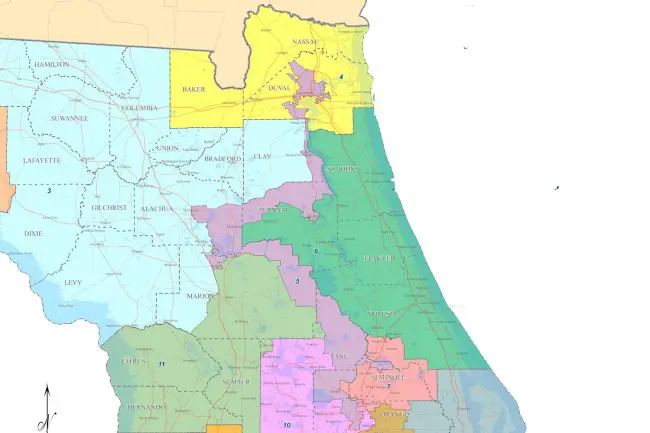
In a highly anticipated ruling, a Leon County judge struck down a map of the state’s congressional districts drawn by the Legislature in 2012, potentially throwing the political future of the state into turmoil.
But the ruling, issued by Circuit Judge Terry Lewis, is virtually certain to be appealed and end up before the Florida Supreme Court, meaning that this year’s elections will likely proceed normally.
Legislative leaders were reviewing the ruling late Thursday, according to their offices. But a lawyer for voting-rights groups challenging the map said it was “very satisfying” to see Lewis’ opinion and said his side was ready for an appeal.
“We’re very optimistic that the Supreme Court will uphold the ruling,” attorney David King said.
The order, issued late Thursday, is the first to address the state’s congressional map under the anti-gerrymandering Fair Districts constitutional amendments, approved by voters in 2010. The Supreme Court already invalidated the Legislature’s first draft of a state Senate plan, which was then redrawn before the 2012 elections.
Lewis’ ruling specifically takes aim at the districts represented by Democratic Congresswoman Corrine Brown and Republican Congressman Daniel Webster. Brown’s District 5, which winds its way from Jacksonville to Orlando, has been criticized for years as one of the worst examples of gerrymandering in the nation.
District 5 wraps itself around much of the western flank of District 6, which includes all of Flagler County. If District 5 is re-drawn, it would likely affect District 6, which is currently represented by Republican Ron DeSantis.
It isn’t clear when lawmakers might have to redraw the districts, especially given the likelihood of an appeal. Lewis’ ruling doesn’t set a deadline, and candidates have already qualified for the 2014 elections under the boundaries approved by the Legislature.
But if the lines are redrawn after appeals play out, any changes to the Webster and Brown districts are likely to ripple through the rest of the map, given that all congressional districts have to have equal populations. Moving voters into or out of the two districts thrown out by Lewis would have a domino effect on surrounding seats.
According to Lewis, lawmakers and the staff members charged with the once-a-decade redistricting process tried to shield the map drawers from political influence, even as Republican political consultants tried to find a way to manipulate the process.
“That being said, the circumstantial evidence introduced at trial convinces me that the political operatives managed to find other avenues, other ways to infiltrate and influence the Legislature, to obtain the necessary cooperation and collaboration to ensure that their plan was realized, at least in part,” Lewis wrote. “They managed to taint the redistricting process and the resulting map with improper partisan intent. There is just too much circumstantial evidence of it, too many coincidences, for me to conclude otherwise.”
Lewis also found fault with explanations offered by the Legislature for some of the damning evidence at the trial. For example, one key email featured Kirk Pepper, an aide to then-House Speaker Dean Cannon, asking a political consultant whether some unstated issues with Webster’s Orlando-area district related to “performance or geography.”
The state had argued that Pepper was being sarcastic.
“Mr. Pepper testified that, though it may seem that they were discussing political performance, his reply to his friend was actually a signal reminding him that they should not discuss such things. Perhaps, but that is a very unusual and illogical interpretation,” Lewis wrote.
Much of the district-specific testimony at the trial focused on Brown’s seat, which was originally created in the 1990s to provide African-Americans with the opportunity to elect a candidate of their choice. Legislative leaders and staff members argued at trial that increasing the district’s black voting-age population, or BVAP, to more than 50 percent would shield it from a challenge under the federal Voting Rights Act.
But voting-rights organizations opposed to the map, like the League of Women Voters, countered that the district was really meant to carve out enclaves of Democratic-leaning voters and make surrounding districts more friendly to the GOP. Lewis largely agreed.
“I also find that the decision to increase the district to majority BVAP, which was accomplished in large part by creating the finger-like appendage jutting into District 7 and Seminole County, was done with the intent of benefiting the Republican Party,” he wrote.
As for Webster’s district, Lewis rejected an argument from the state that lawmakers included an “appendage” of white voters in the plan as part of their efforts to create a Central Florida district where Latinos could influence the outcome of elections.
“There was no evidence to suggest that a Hispanic majority district could be created in Central Florida. Defendants cannot justify deviation from a … constitutional requirement because of a desire to create a Hispanic influence district,” Lewis wrote.
–Brandon Larrabee, News Service of Florida





























Flatsflyer says
Good start, now I hope the Courts will expand the challenges and put the Tea Baggers in their place. Gerrymandering needs to end once and for all. The people spoke in 2010 and the Republican Party again, and again ignored the wishes of the people. This County, State and Country will not be a safe place to live until all the Conservative Facists are either behind bars or deported to Somalia.
confidential says
Gerrymandering was the one way GOP wanted to win the last elections…shame!
Florida native says
That’s funny it’s like calling the kettle black, when the term gerrymandering was created due to the Democratic Party doing what your complaining about now.